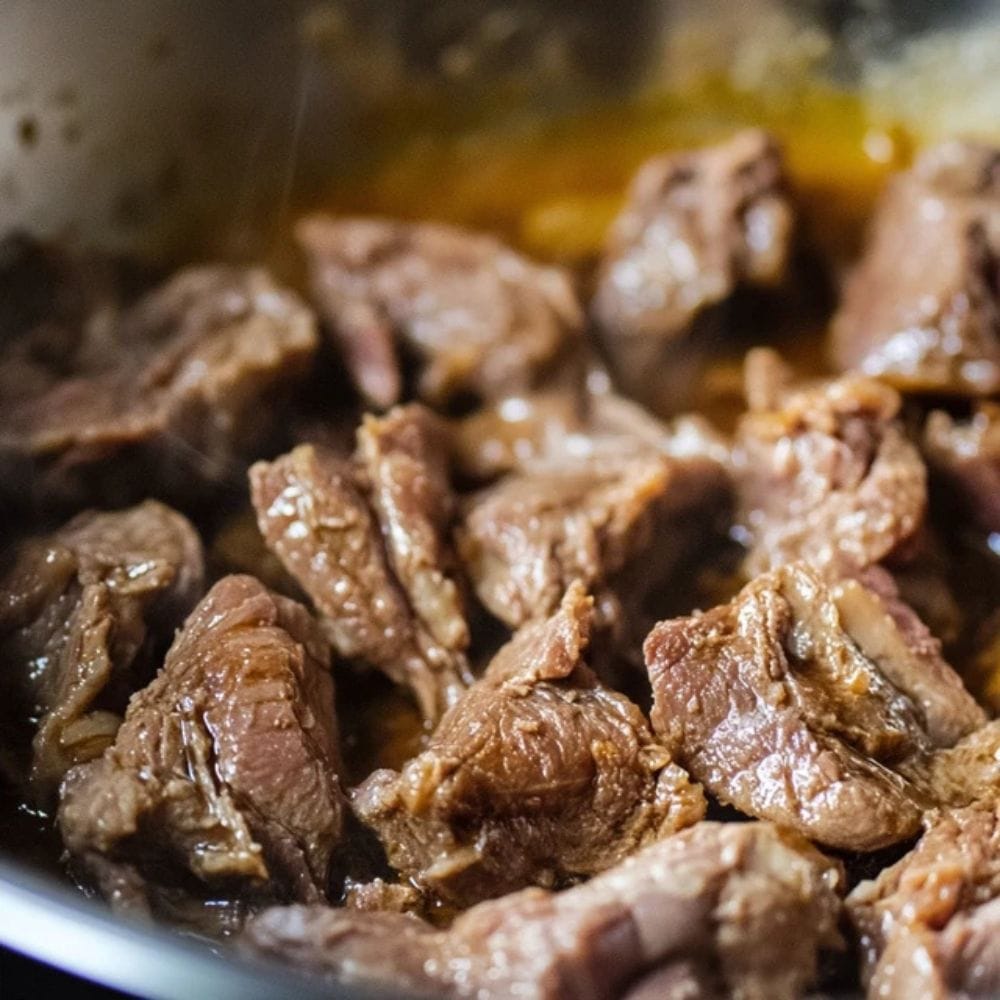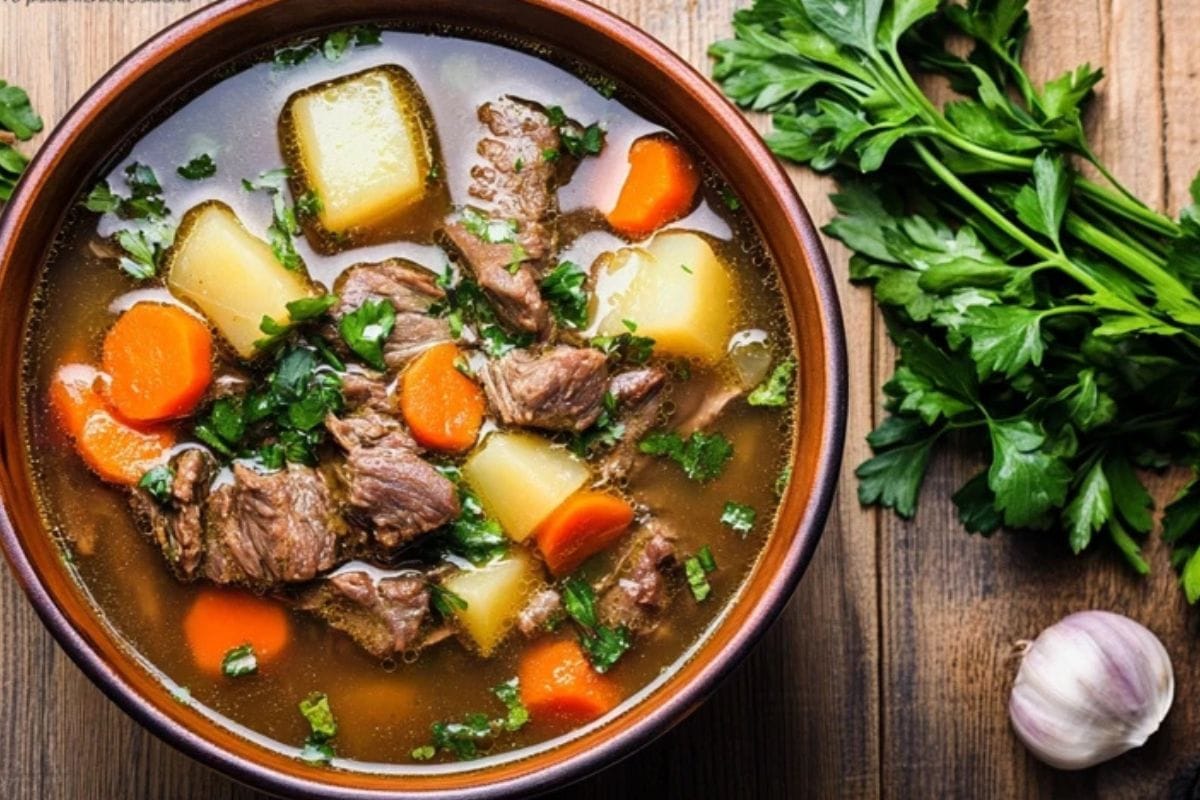Porcupine soup is a bold dish that mixes heritage with a taste of adventure. The first time I tried porcupine soup, I felt a spark of curiosity. Now I often turn to this dish when I want something hearty. Because it has such a distinctive flavor, it remains close to my heart. Yet it also ties us to old traditions that some cooks cherish. So I urge you to explore it without fear.
And porcupine soup offers a firm reminder of how game meats can bring depth to our dining tables. It gives a rich broth and tender bites of meat, while it supports a sense of history. But the taste is not the only draw. Many folks find porcupine soup to be a nutritious meal. Once you try it, you might see why this recipe stands out. Now let’s look at the key points that make it shine.
Why You’ll Love This Porcupine Soup
Key Benefits of Making Porcupine Soup
Porcupine soup delivers a deep, savory richness that appeals to both adventurous eaters and those looking for a nourishing meal. Its simple preparation makes it perfect for busy weeknights, yet its unique flavor can turn it into a conversation starter at festive gatherings. Whether you’re making it for yourself or sharing it with guests, this dish offers both comfort and culinary curiosity.
- Approachable for beginners – Easy steps make it accessible for new cooks.
- Ideal for different occasions – Works for casual dinners or special gatherings.
- Lean yet satisfying – Game meat is lower in fat but still rich in flavor.
- Traditional and time-honored – Keeps heritage cooking alive.
Many believe porcupine soup nurtures both body and soul. The lean meat offers a healthier alternative while maintaining a deeply satisfying taste. If you’re looking for an old-fashioned dish with a new twist, this recipe is the perfect way to explore new flavors in your kitchen.
A key consideration is respecting the source of your game meats. Ethical harvesting honors traditions and sustains the land, ensuring that this meal remains a meaningful experience.
Is This Porcupine Soup Right for You?
Some may wonder if porcupine soup is too unfamiliar for their taste, but this dish is surprisingly welcoming. It provides a gentle introduction to wild game flavors and suits cooks eager to try indigenous-inspired meals without requiring special equipment or advanced culinary skills.
- Great for curious cooks – A unique dish that’s easy to prepare.
- Perfect for hunters and foragers – A rewarding way to use ethically sourced game.
- Mild yet robust – The meat has a mild gamey quality that pairs well with vegetables.
- Slow-simmered for tenderness – Ensures a soft and flavorful bite in every spoonful.
For those who prefer milder flavors, adding extra herbs or a splash of citrus can brighten the broth and balance the dish. Whether you’re embracing wild game for the first time or already enjoy rustic, traditional cooking, porcupine soup is a hearty, comforting choice worth exploring.
The Story Behind the Recipe
Many families pass along recipes that showcase nature’s bounty. This dish holds special meaning in regions where wild game forms part of daily life. Some indigenous groups kept this tradition alive for centuries. They wasted nothing, and porcupine soup became a proud staple. And that heritage still resonates today.
Because it draws on resourcefulness, porcupine soup reminds us of survival instincts. Yet it also represents a celebration of the land’s offerings. If you crave deeper insight, you may explore the roots by looking at honoring native foodways. Now let’s see how this recipe traveled to modern tables, bringing folks together.
Ingredients You’ll Need for Porcupine Soup
Full Ingredient List for Porcupine Soup
Many folks fear they won’t find special items. But porcupine soup only needs simple pantry staples. And a hearty cut of porcupine meat, if you can source it from a wild game provider, is the key. Yet you can adapt this with more common meats if needed.
Cooking porcupine soup starts with a good stock and fresh produce. So gather what you can, and set aside enough time to let it simmer. Because a long simmer helps the flavors bloom, patience pays off. Now here’s what you’ll need:
- 2 lbs porcupine meat, cleaned and cubed
- 4 cups vegetable broth
- 3 medium carrots, sliced
- 2 large potatoes, cubed
- 1 large onion, chopped
- 3 garlic cloves, minced
- 2 celery stalks, sliced
- 2 bay leaves
- Salt and pepper, to taste
- Fresh herbs (like parsley or thyme) for garnish
Ingredient Tip: Pick vegetables you enjoy most. If you like added color, toss in bell peppers or fresh peas.
Ingredient Substitutions for Porcupine Soup
Some cooks hesitate to use porcupine meat. But you can easily swap with familiar cuts. And your soup will still taste rich. Yet keep in mind that each meat type alters flavor slightly. So choose wisely if you want to preserve that mild game essence.
| Ingredient | Substitute | Notes |
|---|---|---|
| Porcupine meat | Lean pork or chicken | Watch the cooking time and adjust. |
| Vegetable broth | Chicken broth | Expect a shift in flavor depth. |
| Potatoes | Sweet potatoes or yams | Gives extra sweetness and color. |
| Fresh herbs | Dried herbs | Use half the amount for best balance. |
How to Make Porcupine Soup Step-by-Step

Prepare the Meat
- Rinse and pat dry: Clean meat makes for a purer taste and avoids grit.
Brown the Meat
- Heat oil in a large pot: Add cubed porcupine meat and cook until browned on all sides.
- Tip: Browning seals in juices and adds deeper flavor.
Sauté the Vegetables
- Remove meat and set aside.
- Add onions, garlic, celery, and carrots to the pot: Cook until onions are translucent.
- Tip: This step brings out the veggies’ natural sweetness.
Combine Ingredients
- Return meat to the pot.
- Add potatoes, vegetable broth, bay leaves, salt, and pepper.
- Bring to a gentle boil: This fuses flavors into a hearty base.
Simmer
- Lower heat and let it simmer for about two hours.
- Tip: Patience ensures tender meat and cohesive flavors.
Taste and Adjust
- Remove bay leaves.
- Check seasoning and adjust as needed.
- Garnish with fresh herbs before serving.
- Tip: Herbs give a bright note to round out the bowl.
Cooking Times for Porcupine Soup
| Cooking Process | Estimated Time |
|---|---|
| Prep Time | 20 minutes |
| Browning Meat | 10 minutes |
| Sautéing Vegetables | 5 minutes |
| Simmering | 2 hours |
| Total Time | 2 hours 20 minutes |
This slow-cooked soup rewards patience with deep flavors and a hearty texture. Enjoy a warming bowl with fresh bread on the side!
Expert Tips for Perfect Results
Some folks worry about dryness. But porcupine soup stays moist if you let it simmer long enough. And you might also rest the cooked meat before you serve it. Because resting helps hold the juices, it prevents a tough bite. Now keep the lid on for most of the simmer to keep moisture inside.
If you crave more flavor, you can add spices like cumin or paprika. Yet be careful not to overpower the mild taste of porcupine soup. So a balanced approach often works best. Try tasting as you go. Because wild game meats differ from store cuts, you might want to check out the wild game meats nutrition guide for further advice.
Seasonal Variations to Try
Sometimes you want a lighter soup in the warmer months. And other times, you long for a comforting stew on cold evenings. Because porcupine soup is adaptable, you can tweak it each season. Yet the base remains the same, giving you the taste you love. Now let’s explore two distinct paths.
Spring and Summer Variations for Porcupine Soup
A sunny day calls for crisp veggies. So try adding zucchini or fresh tomatoes. And you can toss in basil or cilantro to bring a bright note. Yet keep the simmer shorter if you prefer a crisper bite. Because the warmer weather invites lighter meals, serve it with a side salad.
Some people swap potatoes for corn to cut starch. But you can add diced peppers or peas for color. And the result will feel lively. Now here’s a quick table to guide you:
| Season | Ingredient Twist | Serving Suggestion |
|---|---|---|
| Spring | Zucchini, fresh peas | Pair with a small garden salad |
| Summer | Tomatoes, bell peppers | Enjoy with iced tea |
Fall and Winter Variations for Porcupine Soup
The chill in the air begs for hearty comfort. So add parsnips or butternut squash to boost warmth. And season with thyme or rosemary. Yet keep an eye on thickness, since root veggies thicken the broth. Because these flavors lean earthy, a splash of apple cider vinegar can perk them up.
Many enjoy a side of crusty bread in colder months. And some even top their porcupine soup with shredded cheese for extra richness. But watch the salt. Now let the soup simmer until the meat is fork-tender for a cozy delight.
Nutritional Insights into This Dish
Game meats often carry an appealing health profile. Porcupine soup can serve as a lean protein choice. And it’s rich in iron, which supports energy. Because the meat comes from a wild source, it typically lacks added hormones. Yet the real benefit is taste without guilt.
If you seek more information, you can check the health benefits of wild game meats. So you might find extra reassurance about this dish’s value. But keep in mind that balance matters. And those watching sodium can replace salt with fresh herbs or a splash of lemon juice.
Serving Suggestions and Pairings
Best Drinks to Complement Porcupine Soup
A good drink enhances the flavors of porcupine soup, balancing its hearty, rustic taste. Whether you prefer something bold or mild, the right pairing can elevate your meal.
- Bold red wine – A full-bodied red, like Cabernet Sauvignon or Malbec, complements the meaty depth.
- Sweet tea – A Southern-style iced tea adds a mild, soothing contrast.
- Ginger-infused water – Light and refreshing, it cleanses the palate.
- Herbal tea (sage or chamomile) – Brings an earthy note that pairs well with game meats.
Since porcupine soup has a rich, slow-cooked base, lighter beverages can keep your palate refreshed between bites. Ginger or herbal teas add a subtle spice that enhances the rustic quality of the dish.
Best Side Dishes for a Balanced Meal
Pairing the right side dish can make porcupine soup feel like a complete meal. Options that add freshness or crunch help balance the heartiness of the broth.
- Roasted vegetables – Carrots, parsnips, or squash bring a natural sweetness that complements the savory broth.
- Crisp coleslaw – A refreshing slaw with vinegar dressing cuts through the richness.
- Crusty bread – A warm, rustic loaf is perfect for soaking up the flavorful broth.
- Steamed wild rice – Adds an earthy, nutty component that pairs well with game meat.
A combination of textures—like a warm soup with a crunchy side—keeps the meal exciting and satisfying.
Common Mistakes to Avoid
Preventing Off-Flavors and Tough Meat
Game meats have a unique profile, but improper preparation can lead to strong or undesirable flavors. Taking the right steps ensures a smooth, well-balanced dish.
- Clean and trim the meat properly – Remove any excess fat or sinew to avoid strong, off-putting flavors.
- Don’t rush the simmer – A slow, steady cook (at least two hours) is necessary to break down the meat properly.
- Add broth as needed – If the soup starts to feel too dry, pour in extra stock halfway through cooking.
Beginners often make the mistake of hurrying the cooking process. Game meats require patience—slow cooking ensures tenderness and a fully developed flavor.
Balancing Seasoning and Consistency
Getting the right seasoning is key to a flavorful porcupine soup, but over-salting or thickening mistakes can throw off the dish.
- Wait to add salt – The broth reduces as it simmers, concentrating flavors. Seasoning too early can lead to an overly salty soup.
- Adjust thickness as needed – If the soup becomes too thick, thin it out with a bit of extra broth or water.
- Taste as you go – Small adjustments early on can help you avoid major corrections later.
By keeping an eye on these details, you can make a perfectly balanced porcupine soup that highlights the meat’s natural flavors while staying smooth and comforting.
FAQs About This Soup
Can I replace porcupine meat with other wild game cuts?Does porcupine soup taste strong or gamy?Is porcupine soup safe for everyone?Can I make this soup in a slow cooker?Does porcupine soup provide enough protein?
Final Thoughts
Porcupine soup can serve as a window into timeless practices. It offers a taste of wild tradition with each spoonful. And the dish proves that game meats can be simple and rewarding. Yet it also encourages us to try what we might have overlooked. Because there’s more to cooking than sticking to the usual cuts, it broadens our palate.
If you’re ready to try something beyond routine meals, give this soup a chance. Let the meat simmer, let the flavors meld, and let the aroma fill your home. Now gather friends or family, share a bowl, and see why this recipe holds a special place in rustic kitchens everywhere.

Porcupine Soup
Equipment
- Large Pot
- Wooden Spoon
- Knife
Ingredients
Main Ingredients
- 2 lbs porcupine meat cleaned and cubed
- 4 cups vegetable broth
- 3 medium carrots sliced
- 2 large potatoes cubed
- 1 large onion chopped
- 3 cloves garlic minced
- 2 stalks celery sliced
- 2 bay leaves
Garnish
- 2 tbsp fresh herbs such as parsley or thyme
Instructions
- Rinse and pat dry the porcupine meat to remove any grit.
- Heat oil in a large pot over medium heat. Add cubed porcupine meat and brown on all sides. Remove and set aside.
- In the same pot, add onions, garlic, celery, and carrots. Sauté until onions become translucent, about 5 minutes.
- Return the browned meat to the pot. Add potatoes, vegetable broth, bay leaves, salt, and pepper. Bring to a gentle boil.
- Lower heat and let simmer for about 2 hours, stirring occasionally.
- Remove bay leaves. Taste and adjust seasoning as needed.
- Garnish with fresh herbs before serving. Enjoy hot!






